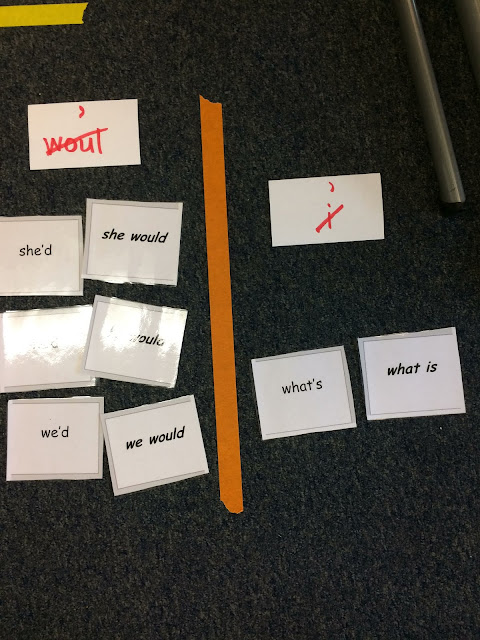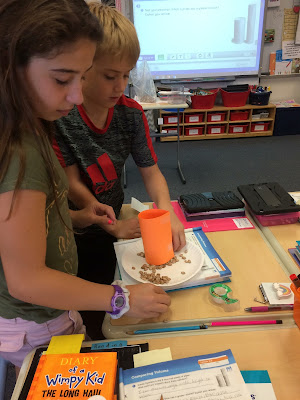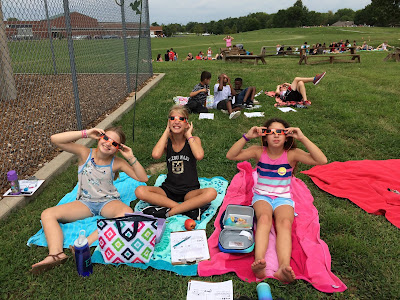Fifth graders helping Kindergarten buddies https://t.co/f3TPVznt9k
— Ms.Thelen (@thelensthinkers) September 28, 2017
Thursday, September 28, 2017
Getting together with our buddies!
Friday, September 22, 2017
Word Work with Contractions
A small group worked on contractions and how the apostrophe signals that two words have been combined to create one new word. Typically, the apostrophe takes the place of the vowel. But in a few examples, can take the place of most of a word!
This category is the "a" replacement.
The "ha" and "o" replacement.
The unique "almost a full word-woul" and the "i" replacement.
Thursday, September 21, 2017
Collaborating on Planning a Narrative
Students are working with their writing partners to lay the foundation for a planned story. Narratives have a "way of being". Knowing that we can use this as a formula should provide us with support as we produce our own narratives.
Students are planning a narrative with their writing partners https://t.co/Wi9nQxEUkR
— Ms.Thelen (@thelensthinkers) September 21, 2017
Wednesday, September 20, 2017
Taking our Notes and Making our Presentation on Colonists
Last week, students spent time researching information about the colonists. Students used their textbook, primary sources, video, and trade books.
Students took notes and are now ready to collaborate to build their presentation. Each group member is responsible for contributing to a slide in the presentation. Our lesson for today was how we need to put "highlights" on the slide so that the text is not overwhelming. Students also were introduced to the "speaker's notes" where they can add additional information to help them when they present.
You can see there are six students working on this presentation at the same time.
Students will be presenting their portion of the presentation while the rest of the class is taking notes. This will be their first attempt at taking notes while a speaker is presenting. In other words, they have to summarize the information they hear and write down the important parts. A valuable skill to have!
Students took notes and are now ready to collaborate to build their presentation. Each group member is responsible for contributing to a slide in the presentation. Our lesson for today was how we need to put "highlights" on the slide so that the text is not overwhelming. Students also were introduced to the "speaker's notes" where they can add additional information to help them when they present.
You can see there are six students working on this presentation at the same time.
Students will be presenting their portion of the presentation while the rest of the class is taking notes. This will be their first attempt at taking notes while a speaker is presenting. In other words, they have to summarize the information they hear and write down the important parts. A valuable skill to have!
Thursday, September 14, 2017
Researching Colonization
Researchers on the the Southern colonies https://t.co/DSfkn9GhAV
— Ms.Thelen (@thelensthinkers) September 14, 2017
Tuesday, September 12, 2017
Shoreline Investigation
Students are investigating how the oceans' waves and currents can shape landforms. This investigation is particularly relevant as students are paying attention to the recent hurricane's on the news. Students were able to see how the water encroached on their "beach" to show erosion. The waves and currents pick up the sediments and move them away.
Friday, September 8, 2017
Learning about Area and Volume
Students have been working hard to learn concepts about area and volume.
Last week, we learned that we can find the area of a square by multiplying the length by the width. A=L * W a formula we may remember from our school days. Students are also thinking about how we may find the number of pieces that cover that "square area"--including using the fractional parts.
For example:
How many 1/2 ft squares or parts would you need to fill one square foot?
It would take four 1/2 square feet pieces to create one square foot.
We were looking for a pattern to help us solve other problems. Some noticed that if we multiply the denominators, we will get the number of pieces needed to cover the square foot. In the second example, it would take nine 1/3 square feet pieces to cover one square foot.
Last week, we learned that we can find the area of a square by multiplying the length by the width. A=L * W a formula we may remember from our school days. Students are also thinking about how we may find the number of pieces that cover that "square area"--including using the fractional parts.
For example:
How many 1/2 ft squares or parts would you need to fill one square foot?
It would take four 1/2 square feet pieces to create one square foot.
We were looking for a pattern to help us solve other problems. Some noticed that if we multiply the denominators, we will get the number of pieces needed to cover the square foot. In the second example, it would take nine 1/3 square feet pieces to cover one square foot.
This week, we transitioned to volume. Students have been working to find the volume using either of the following formulas:
V = L * W * H or V = B * H
Students were also working to visualize the size of various cubic units. We have worked with cubic centimeters, cubic decimeters, and cubic meters. Below, you can see us building a cubic meter.
These first few days in math have been challenging. However, it is exciting to see students think deeply about math!
Saturday, September 2, 2017
Building the Narrative Arc with Mentor Texts
Students are correlating the narrative arc from their reading to their writing. We are identifying story elements, theme, and plotting stories using the narrative arc. Using three different books, we are seeing the relationship between books that we read and how we are writers.
Books we have used as mentor texts:
Books we have used as mentor texts:
We will go back to these texts next week to introduce some reading structures from the text Disrupting Thinking by Kylene Beers and Bob Probst. Using a BHH model where we think about the Book's details, how it impacts our Head, and our Heart is where we are headed next.
Earth Systems in Science
Students have begun our unit on Earth Systems. We are thinking about how earth's systems interact. Students are being introduced to the systems of Earth: biosphere, geosphere, hydrosphere, and atmosphere.
Before starting our unit, students are sorting picture cards into categories that they assigned together. Some students did living/nonliving. Some students did weather, people, landforms, etc...
Students are being introduced to the academic vocabulary through our textbook and are recording what each system means. We have focused on the Greek root words and have applied these root words to other words that contain geo/atmo/bio/hydro/sphere.
Before starting our unit, students are sorting picture cards into categories that they assigned together. Some students did living/nonliving. Some students did weather, people, landforms, etc...
Students are being introduced to the academic vocabulary through our textbook and are recording what each system means. We have focused on the Greek root words and have applied these root words to other words that contain geo/atmo/bio/hydro/sphere.
On Friday, we went outside to take pictures showing examples of how these systems interact. We will continue to document the earth's systems throughout the seasons. Next week, we will be building some models to help us understand and simulate how these systems work.
Getting started with Math
This school year, all of Columbia Public Schools are implementing new math materials. The series that we are using is called Everyday Math. This new program is rigorous and rich with opportunities to see math being applicable to life.
Total Solar Eclipse 2017
Preparing for the Solar Eclipse...
Students did some reading and viewing of a variety of information from a Padlet prepared by Mrs. Burke's.
Students did some reading and viewing of a variety of information from a Padlet prepared by Mrs. Burke's.
Actual Viewing of the event!
This was a day we will never forget!
Building Community through Team Work Activities
One back to school activity students worked through at the beginning of the school year was "Survival Island". (Idea from the book Teach Like a Pirate.) Students have to decide who gets to stay on the island and who gets to leave the island with the hope of being rescued.
Students come to understand that we are all contributors to the group. We may have strengths and weaknesses that we bring to the group. Working together and listening to each other is key!
Another team building activity is the "Paper Circle" challenge. Working in small groups, students are provided with 2 pieces of paper, 2 pairs of scissors, and one glue stick. They are tasked with creating a paper circle that everyone in their group can stand in when completed.
Students have to communicate, assign roles, take turns, share, and negotiate with their classmates in order to complete the task.
Subscribe to:
Comments (Atom)



























































